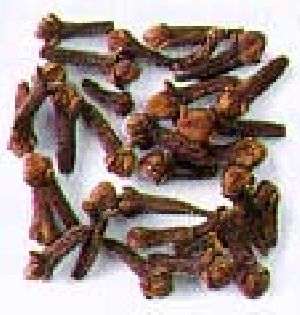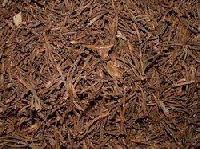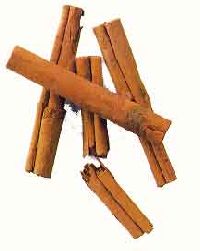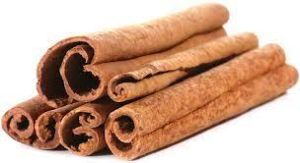
Dry Cloves
Clove, small, reddish-brown flower bud of the tropical evergreen tree Syzygium aromaticum of the family was important in the earliest spice trade and believed in indigenous to the Moluccas or Spice Islands (now Maluka), of Indonesia. The people of the Moluccas used to plant a clove tree to celebrate the birth of a child and would wear a necklace of cloves as a protection from evil spirit and illness. Strong in aroma and hot and pungent in taste, cloves are used to flavour many foods, particularly meats and bakery products; in Europe and the USA the spice is a characteristic flavouring in Christmas holiday fare, such as wassail and mincemeat. The name clove is believed to be derived from the French word clou meaning nail due to the appearance of this spice. As early as 200 BC, envoys from Java to the Han-dynasty court of China brought cloves that were customarily held in the mouth to perfume the breath during audiences with the emperor. During the late Middle ages, cloves were used in Europe to preserve, flavour, and garnish food. Clove cultivation was almost entirely confined to Indonesia, and in the early 17th century the Dutch eradicated cloves on all islands except Amboina and Ternate in order to create scarcity and sustain high prices. In the latter half of the 18th century the French smuggled cloves from the East Indies to Indian Ocean islands and the New World, breaking the Dutch monopoly. Cultivation The clove tree is an evergreen that grows to about 8 to 12 m in height. Its gland-dotted leaves are small, simple and opposite. The trees are usually propagated from seeds that are planted in shaded areas. Flowering begins about the fifth year; a tree may annually yield up to 75 pounds (34 kg) of dried buds. The buds, just before the flowers open, are hand-picked in late summer and again in winter and are then sun-dried. The island of Zanzibar, which is part of Tanzania, is the world's largest producer of cloves. Madagascar and Indonesia are smaller producers. Cloves vary in length from about 1/2 to 3/4 inch (13 to 19 mm). Cloves contain 14 to 20 percent essential oil, the principal component of which is the aromatic oil eugenol (70 - 90%). Cloves are strongly pungent owing to eugenol, which is extracted by distillation to yield oil of cloves. Three essential oils are available from this spice: clove bud oil, clove stem oil and clove leaf oil. Each has different chemical composition and flavour. Clove bud oil, the most expensive and the best quality product, contains eugenol (80 - 90%), eugenol acetate (15%) and beta caryophyllene (5 - 12%). Culinary use Cloves are ingredients in many classic spice mixtures. Whole cloves are frequently used to flavour cooking liquids for simmering fish, poultry, game and meat. They feature in classic sauces and are used in the bakery industry and the processed meats industry as a ground spice. Medicinal and other use The clove oil is used to prepare microscopic slides for viewing and is also a local anesthetic for toothaches. It is a strong antiseptic and preservative. It is used to treat flatulence, colic, indigestion and nausea. Eugenol is used in germicides, perfumes and mouthwashes, in the synthesis of vanillin, and as a sweetener or intensifier.
...more
Clove Stem
The clove tree is an evergreen that grows to about 8 to 12 m in height. Its gland-dotted leaves are small, simple and opposite. The trees are usually propagated from seeds that are planted in shaded areas. Flowering begins about the fifth year; a tree may annually yield up to 75 pounds (34 kg) of dried buds. The buds, just before the flowers open, are hand-picked in late summer and again in winter and are then sun-dried. The island of Zanzibar, which is part of Tanzania, is the world's largest producer of cloves. Madagascar and Indonesia are smaller producers. Cloves vary in length from about 12 to 34 inch (13 to 19 mm). Cloves contain 14 to 20 percent essential oil, the principal component of which is the aromatic oil eugenol (70 - 90%). Cloves are strongly pungent owing to eugenol, which is extracted by distillation to yield oil of cloves. Three essential oils are available from this spice: clove bud oil, clove stem oil and clove leaf oil. Each has different chemical composition and flavour. Clove bud oil, the most expensive and the best quality product, contains eugenol (80 - 90%), eugenol acetate (15%) and beta caryophyllene (5 - 12%).
...more
Cinnamon Spice
Cinnamon, a bushy evergreen tree of the laurel family (Lauraceae) is native to Sri Lanka (Ceylon), the neighbouring Malabar Coast of India, and Myanmar (Burma) and also cultivated in South America and the West Indies for the spice consisting of its dried inner bark. The spice is light brown in colour and has a delicately fragrant aroma and warm, sweet flavour. It is lighter in colour and milder in flavour than the other related species.
...more
Cinnamon
Cinnamon, a bushy evergreen tree of the laurel family (Lauraceae) is native to Sri Lanka (Ceylon), the neighbouring Malabar Coast of India, and Myanmar (Burma) and also cultivated in South America and the West Indies for the spice consisting of its dried inner bark. The spice is light brown in colour and has a delicately fragrant aroma and warm, sweet flavour. It is lighter in colour and milder in flavour than the other related species. Cinnamon was once more valuable than gold and has been associated with ancient rituals of sacrifice or pleasure. In Egypt, it was sought for embalming and witchcraft; in medieval Europe for religious rites and as flavouring. References to cinnamon are plenty throughout the Old Testament in the Bible. Later it was the most profitable spice in the Dutch East India Company trade. Botany Cinnamon is a bushy evergreen tree (6-8 m tall), cultivated as low bushes to ease the harvesting process. The leaves are long (10-18 cm), leathery and shining green on upper surface when mature. The flowers have a fetid, disagreeable smell. The fruit is a dark purple, one-seeded berry. It prefers shelter and moderate rainfall without extremes in temperature. Eight to ten lateral branches grow on each bush and after three years they are harvested. The Sri Lankan farmer harvests his main crop in the wet season, cutting the shoots close to the ground. In processing, the shoots are first scraped with a semicircular blade, then rubbed with a brass rid to loosen the bark, which is split with a knife and peeled. The peels are telescoped one into another forming a quill about 107 cm (42 inches) long and filled with trimming of the same quality bark to maintain the cylindrical shape. After four or five days of drying, the quills are rolled on a board to tighten the filling and then placed in subdued sunlight for further drying. Finally, they are bleached with sulphur dioxide and sorted into grades. Aroma and flavour Cinnamon contains from 0.5 to 1 present essential oil, the principal component of which is cinnamic aldehyde (about 60%). Other components are eugenol, eugenol acetate, and small amounts of aldehydes, ketones, alcohols, esters and terpenes. The oil is distilled from fragments for use in food, liqueur, perfume and drugs. The aldehyde can also be synthesized. Cinnamon leaf oil is unique in that it contains eugenol as its major constituent (70-90%). Culinary, medicinal and other use In modern times, cinnamon is used to flavour a variety of foods, from confections to curries; in Europe and the USA it is especially popular in bakery goods. The stick cinnamon is added whole to casseroles, rice dishes, mulled wines and punches, and to syrups for poaching fruit. The chips are also used in tea infusions or spiced cider blends. Ground cinnamon is used in baked goods like cakes, pasteries and biscuits. Cinnamon leaf oil is used in processed meats, condiments and also in bakery items. Oil from the bark is used in the manufacture of perfume. The cinnamic aldehyde and/or eugenol present are both antifungal agents. Cinnamon is a stimulant, astringent and carminative, used as an antidote for diarrhoea and stomach upsets.
...more
Chilli
Chilli or pepper (Capsicum) is any of a great number of plants of the night shade family, Solanaceae, extensively cultivated throughout tropical Asia and equatorial America for their edible, pungent fruits. India is the largest producer and exporter of chillies. The genusCapsicum comprised all the varied forms of fleshy-fruited peppers grown as herbaceous annuals - the red, green, and yellow pepper rich in vitamins A and C that are used in seasoning and as a vegetable food. It includes paprika, chili pepper, red pepper (cayenne), and bell peppers. The latter one is considered and eaten as a vegetable and is not covered in this section. The capsicums under each category vary tremendously and the species designation is not always possible. In general, paprika belongs to C.annum and the red peppers and chili peppers belong to the C.frutescens species. The name chilli is believed to be derived from an ancient Indian word txile. The term "pimiento," from the Spanish for "pepper", is applied to certain mild pepper varieties possessing distinctive flavour but lacking in pungency; these include the European paprikas, which include the paprika of commerce, a powdered red condiment that was known in Hungary by the late 16th century. Botany The chilli plant is bush-like, grows up to about 0.6m and bears white flowers that produce fruits in a variety of sizes, colours and shapes. The plants grow at altitudes from sea level to 1,800 m above MSL in the tropics. Their pungency is influenced by several factors, such as high night temperatures and drought or over-watering. Cultivation Pepper plants are treated as tender summer annuals outside their native habitat. They are propagated by planting seed directly in the field or by transplanting seedlings started in green houses or hotbeds after 6-10 weeks. Green chillies are immature fruits and red chillies have been allowed to ripen for a further 4 weeks. Aroma and flavour The pungency for the red peppers and the colour value for the paprikas are the most important parameters. Hot peppers, used as relishes, pickled or ground into a fine powder for use as spices, derive their pungency from the compound capsaicin (8-methyl-N-vanillyl-6-enamide), a substance characterized by acrid and burning taste, that is located in the internal partitions of the fruit. First isolated in 1876, capsaicin stimulates gastric secretions and, if used in excess, causes inflammation. It is a tasteless, odourless white crystalline substance. Its level varies widely in capsicum peppers, from less than 0.05% in the mildly pungent types to as high as 1.3% in the hottest chillies. The pungency level is usually represented in Scoville heat values. Pungency levels vary in the same variety, by geographical region, and in maturity levels. Volatile oil content is low in all capscicums. The pigment responsible for the colour in paprikas is capxanthin, a carotenoid. Other carotenoids present are capsorubin, zeaxanthin, lutein, kryptoxanthin and alpha and beta-carotene. The pigment content increases as the fruit ripens and continues after maturity.The extractable colour of parika is usually expressed in ASTA colour value or in Colour Units, which are 40 times the ASTA colour. Culinary use Chillies have a chemical effect on our bodies as they stimulate the appetite and cool the body. The chilli flavour revolutionized the cooking of tropical countries. Red pepper is used in a large variety of products, often in the meat and pickling industry in the form of crushed red pepper or ground red pepper. It is used either in the ground form or as oleoresin in any product that has some heat or pungency. A fine powder made from specially mild varieties of pepper, C.annum, is known as paprika. Paprika is used more extensively whenever a red to orange colour is desired such as in processed meats, snack, foods, sauces, gravies, salad dressings etc. Other use Chilli pepper is used primarily in the manufacture of chilli powders. Cayenne pepper is a very fine ground powder from the C.frutescens variety. It is widely used as a seasoning and it is also added to some curries. Chilli powder of chili pepper is the dried ground product of the milder peppers. It is a blended product of different chilies to get the exact flavour profile and colour desired. Chilli peppers are often caramelized to get a burnt flavour note and a surface browned colour. Common heat values for chilli peppers are mild, about 100 Scoville heat units. Tabasco sauce or chilli sauce is a North American seasoning made from extremely hot Tabasco or cone chillies, which are mixed with vinegar and then matured in white oak casks for several years. It is widely used in small quantities as a general seasoning. Chilli is also used as a paste and in crushed form in several dishes.
...more
Cassia Tube
Cassia is a spice consisting of the aromatic bark of the Cinnamomum cassia plant of the family Lauraceae. Similar to true cinnamon, cassia bark has a more pungent, less delicate flavour and is thicker than cinnamon bark. This ancient spice was known to the Chinese as early as 3000 BC and mentioned in the Bible. It was used by the Pharaohs and came into Europe over the spice routes from the East.
...more
Cardamom Seeds
Cardamom, the 'queen of spices', is a rich spice culled from the seeds of a perennial plant, Elettaria cardamomum. It is one of the highly prized spices of the world. It is believed that the original home of this precious spice is the mountains of the South- Western parts of the Indian Peninsula. As early as the 4th century BC cardamom was used in India as a medicinal herb and was an article of Greek and Roman trade. Cardamom is a native of Western Ghats in South India. India had a virtual monopoly of cardamom till recently. But now it is being cultivated in Guatemala, SriLanka, Thailand, Laos, Vietnam, Costa Rica, El Salvador and Tanzania. Cardamom cultivation in India is confined to three states, viz. Kerala, Karnataka and Tamil Nadu. Cardamom is a perennial bushy herb. The tuberous underground rhizome is its real stem and the aerial shoot is a pseudostem and formed by the encircling leaf sheaths. The leaves are distichous, long, alternate and lanceolate acuminate in shape. Flowers are borne on panicles and they emerge directly from the underground stem on long floral stalks. They are hermaphrodite and zygomorphic. The corolla is tubular, 3-lobed, pale green, androecium with petalloid labellum white in colour with pink or purplish veins, composed of three modified stamens with an undulated edge. There are two further rudimentary staminodes and one functional stamen. The fruit are tri-locular, ovoid or oblong, greenish-brown capsules containing about 15-20 seeds attached to axile placenta. Light reddish or dark reddish brown seeds are irregularily 3-sided, transversely wrinkled or furrowed and are covered by a membraneous aril. Cultivation Cardamom grows abundantly in altitudes ranging from 900 to 1370 m above sea level, with a warm humid atmosphere, evenly distributed rainfall and humus-rich loamy soil. It thrives best under moderate shade. Cardamom is propagated both vegetatively and by seeds. Seeds from well ripened fruits are sown in raised beds and when the seedlings attain a height of 25-30 cm they are transplanted into field or secondary nursery beds. Vegetative propagation is by means of clones, a portion of the rhizome with one or two new tillers. Micropropagation is also widely employed for the propagation of cardamom. Planting is normally done in June-July with the receipt of south-west monsoon rains in pits or trenches at a spacing varying from 0.9 to 3.0 m depending on the type of cardamom. The maiden crop in cardamom is obtained in the third year of planting. Flowering commences in April-May and continues till July-August. Harvesting is done at an interval of 30-40 days and only fruits which are just nearing ripeness are harvested. Harvested fruits are dried by exposing them to sun light or by heating or by flue curing. The dried capsules are cleaned, sorted and graded based on bulk density, colour and size. Capsules which lack uniform green colour are bleached by using bleaching powder, sulphur dioxide or hydrogen peroxide. The chemical composition of cardamom varies considerably with variety, region and age of the product. The principal quality of determinant is the content and compositon of the volatile oil. Cardamom contains between 2% and 10% essential oil, out of which the major portion is in seeds. The volatile oil contains about 25-40% cineole, 30-40% a-terpinyl acetate and about 1-2% limonene. Aroma and flavour The cardamom seeds have a warm, slightly pungent and highly aromatic flavour. They are popular seasoning in Oriental dishes, particularly curries and in Scandinavian pasteries. In Middle East countries it is used mostly in the preparation of 'Gahwa', a strong cardamom-coffee concoction. Medicinal and other use The cardamom oil is a precious ingredient in food preparations, perfumery, health foods, medicine and beverages. A good portion is consumed for chewing or as a masticatory item. In medicine, it is used as powerful aromatic, stimulant, carminative, stomachic and diuretic, but rarely used alone. It also checks nausea and vomiting, helps in combating digestive ailments. Herbal lores on this spice suggest it can be used to freshen your breath and support smooth digestion.
...more
Black Pepper Seeds
Black pepper (Piper nigrum), the king of spices, is one of the oldest and the most popular spice in the world. It is a perennial, climbing vine indigenous to the Malabar Coast of India. The hotly pungent spice made from its berries is one of the earliest spices known and is probably the most widely used spice in the world today. It was mentioned as far back as 1000 BC in ancient Sanskrit literature. In early historic times black pepper was widely cultivated in the tropics of Southeast Asia, where it became an important article of overland trade between India and Europe. It became a medium of exchange, and tributes were levied in black pepper in ancient Greece and Rome. In the Middle Ages the Venetian and the Genoese became the main distributors, their virtual monopoly of the trade helping to instigate the search for an eastern sea route. The name pepper comes from the Sanskrit word pippali meaning berry. The plant requires a long rainy season, fairly high temperatures, and partial shade for the best growth. Propagation is usually by stem cuttings. The cuttings are set out near a tree or a pole that will serve as a support. Black pepper plants are sometimes interspersed in tea or coffee plantations. They begin bearing in 2 to 5 years and may produce for as long as 40 years. The berries are picked when they begin to turn red. The collected berries are scalded with boiling water for about 10 minutes, which causes them to turn dark brown or black in an hour. Then they are spread out to dry in the sun for three or four days. The whole peppercorns, when ground, yield black pepper. White pepper is obtained by removing the outer part of the pericarp of the ripened berries. The outer coating is softened either by keeping the berries in moist heaps fir 2 or 3 days or by keeping them in sacks submerged in running water for 7 to 15 days, depending on the region. The softened outer coating is then removed by washing and rubbing or by trampling, and the berries are spread in the sun to dry. Whole white pepper can also be prepared by grinding off the outer coating mechanically. The flavour is less pungent than that of black pepper. Green pepper are immature berries freeze dried or mechanically air dried. They are available pickled in brine or vinegar. Black and white pepper have two main components, the volatile oil and the pungent components, commonly known as piperine. Black pepper contains about 0.6 - 2.6 % essential oil that has the aromatic flavour of black pepper but not the pungency. The level varies depending on the source, maturity and variety. Of the 100 different components in the essential oil, the main ones are a-pinene, b-pinene, 1-a-phellandrene, b-caryophyllene, limonene and sabine-delta-3-carene. The main pungency principle is piperine,the trans, trans form of 1-piperoylpiperidine. Other minor pungent alkaloids are piperidine, piperettine, piperyline, piperanine and piperolein A and B. Aroma and Flavour Black pepper is used in almost all applications where spice is used, with exception of baked goods. It is used universally in sauces, gravies, processed meats, poultry, snack foods etc. Both black and white pepper are used in cuisine worldwide, at all stages of the cooking process and as a table condiment. White pepper has a distinguishably different flavour but is utilized to a lesser extent. Culinary use It is used in processed meats and in applications where dark specking is not desired. Black pepper is added to fruit cakes and gingerbread and is also used as a light seasoning on fresh fruit. Black pepper oleoresin is also used for similar purposes. Medicinal and other use Black pepper has long been recognized as a stimulant to appetite as well as an aid in the relief of nausea. In India it is being used since time immemorial as a medicine for a number of health problems.
...more
tempo traveler
Be first to Rate
Rate This